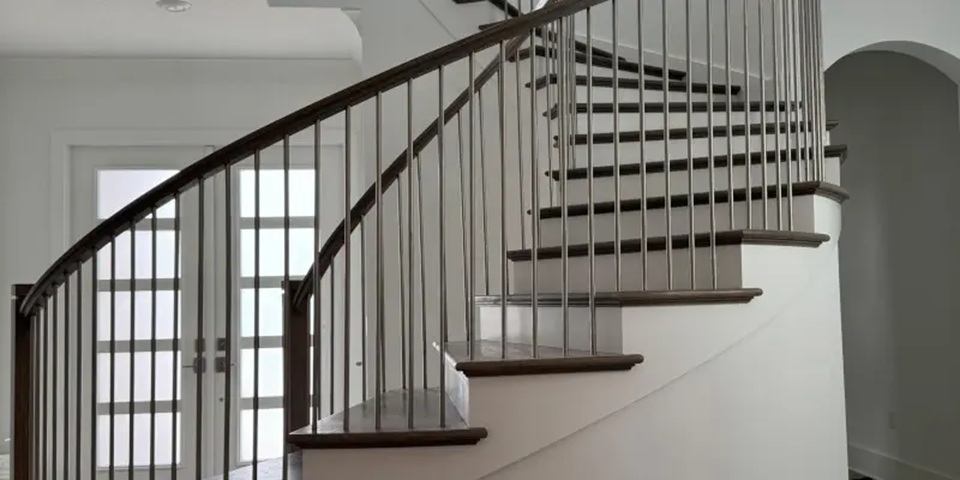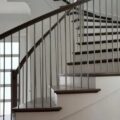Key Takeaways:
- Consistent material selection for floors and stairs enhances design harmony.
- Color and texture alignment are critical in unifying spaces.
- Custom solutions and intentional lighting amplify seamless integration.
- Area rugs and cohesive railings add the finishing touches to the interior flow.
The Importance Of Unified Flooring & Stairs
Creating a cohesive home interior relies on coordinating floors and stairs. When flooring and staircase materials complement each other, they produce a seamless visual flow that boosts aesthetic appeal, sophistication, and continuity. This strategy enables homeowners to craft a clear design story by utilizing coordinated color schemes, materials, and decor. Matching staircases to floors with similar textures or hues guides the eye, making spaces seem larger and adding a hint of luxury. Uniform flooring and stair materials unify different rooms, especially in open-plan layouts, extending sight lines and allowing for a smooth flow from one space to the next. Using consistent materials enhances the sense of space and increases a home’s value by appealing to buyers and elevating its overall design.
Selecting Materials For Seamless Integration
Material selection is foundational when coordinating floors and stairs, as each option offers a distinct character and advantages. Hardwood is popular for seamless transitions due to its timeless look, warmth, and versatility in traditional and modern interiors. Using the same or a complementary species for stair treads and risers ensures a unified appearance and eliminates visual shifts, especially with open staircases where details are visible. Modern homes benefit from continuous surfaces, such as luxury vinyl planks or large-format porcelain tiles, which offer durability and low maintenance. Some homeowners opt for stairs crafted from their floor material, achieved by fabricating custom stair nosings and risers from the same hardwood or flooring products. For reinforced or ornamental stairways, thoughtful railing construction with metal, wood, or glass can enhance harmony, echoing architectural features and tying levels together. Even contemporary spaces feature cohesive transitions, with floating staircases and matching handrails that provide architectural drama while maintaining flow.
Color & Texture Coordination
A unified interior design blends color and texture to bring your vision to life. Using coordinated colors for staircases, floors, walls, and trim eliminates stark contrasts, ensuring a seamless flow between areas. Neighboring hues on the color wheel foster calming harmony, while bold combinations introduce vibrancy. For example, gentle-toned oak stairs paired with tranquil walls promote serenity, whereas striking contrasts like dark wood stairs with white walls are perfect for modern or urban aesthetics. Texture further unifies the space. Combining sleek floors with textured rugs, woven baskets, or plush furniture creates visual interest without clutter. Rustic wood pairs well with vintage decor, while glossy finishes suit minimalist or contemporary styles. Balancing textures adds warmth, depth, and tactile variety, making each surface as thoughtful as the overall color palette.
Custom Solutions For Unique Spaces
Custom solutions for distinctive homes address architectural challenges with specially designed stair nosings, risers, and railings. Advanced flooring options, such as waterproof engineered wood and high-density laminates, improve both durability and aesthetic appeal, making them perfect for high-traffic areas. Design elements like horizontal plank arrangements and stair lighting add sophistication and a cohesive look, turning stairs into striking features in open or multi-level homes and elevating the overall design.
Lighting, Area Rugs, & Accessory Coordination
Accessories in interior design help unify a space, with area rugs anchoring furniture and creating smooth transitions between different flooring surfaces and stairs. Rugs should complement the room’s color scheme and be appropriately sized for the area, reflecting its geometric design. Lighting choices like LED strips and chandeliers enhance material harmony and ambiance, highlighting important design features. Small accessories play a subtle role in maintaining cohesion by mirroring elements from the flooring and stairs, ensuring a seamless flow throughout the interior.
Conclusion
Impeccable home design requires a meticulous approach to harmonizing floor and stair materials, color palettes, textures, and accessories. Opting for continuity in these elements maximizes both visual harmony and home value. Custom options and strategic lighting can further refine this integration, transforming what could be purely functional components into features of beauty, luxury, and cohesion. Thoughtful coordination ensures every element is harmoniously woven into your home’s aesthetic narrative, providing daily enjoyment and long-term appeal.






Leave a Reply